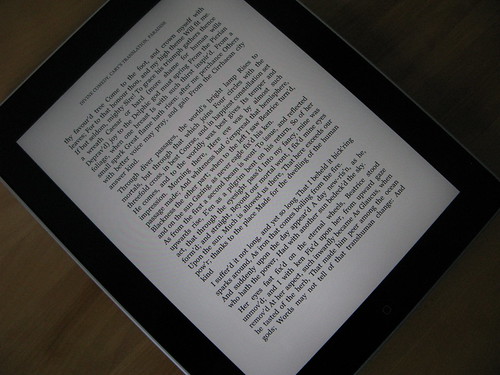Answer is, obviously, "words, words, words."
Q. What's the matter? The matter is contained in the words. Not in the cover art. Not in the spine. And not in the typeface. Groooober says, about typeface:
So the knock against e-books, in my opinion, is that they’re not carefully dressed like print books are. They’re wearing generic uniforms.Fair enough. But think back to your favorite book in the world. Do you have a strong association with the cover art? With the spine of the book? With the size or color of the page?
For me, the answer to the above is yes, but barely. Even the smell of an old book (which is a powerful and distinctive memory) is amazingly secondary to the matter of the words. The ability to read book after book after book on my (lightweight, always in my pocket) phone is, for me, an extraordinary evolution and enhancement of the written word.
What about you, dear reader? Do you like ebooks, or is your relationship with books less about the words and more about the paraphernalia?




I should add that it won't be long before distinctive typeface is as much a characteristic of ebooks as it is of printed books... with the addition of the fact that a user may be able to apply their favorite typefaces to any old book.
ReplyDeleteMy experience with teaching students today is that they do not have the fetish for paper books that older generations do.
ReplyDeletePrinting on hard copy seems wasteful to me given the ease of transferring information electronically.
I hope the Ipad will be the breakthrough e-book reader of the future and help wean older generations off their fetish for hard copy.
If that's so, why are so many of my own students so bad about using library databases? Electronic books available through same? Hell, Google Books? I think "fetish" is a loaded word here, but still, yes, I tend to agree with Safety Neal. It is the trend otherwise, despite my experiences in the library and classroom. I don't own any such e-book device yet. I think the two (print and electronic) can co-exist, especially once we can replace paper with some kind of cyclically-recycled medium. And then, when we're all old, we can give each other old print books as really, REALLY meaningful gifts, just like on Star Trek. Books and Romulan ale.
ReplyDeleteAs I've said before on this blog, I'm interested in engaging my students with online archives and textbook web presences. Another kind of electronic text most of my students seem newly exposed to.
As somebody who reads illustrated books more than text-only books, my take on the print-to-digital shift is beyond just typography. Page layout is certainly important, as is image quality. The iPad, I agree, will do a helluva lot for reading books electronically, illustrated ones included. Kindle couldn't handle photos and other illustrations, but on the iPad many of the books I have in print look great as PDFs on the device. (Gigapedia is great for getting digital twins of books from my library.) Single page layouts work well, but two-page spreads don't, especially if they're composed together as a single cohesive design with images bleeding across the fold, what have you.
ReplyDeleteAs somebody writing a book that has many illustrations and a potentially complex page layout I wonder if the digital version of such a book is just a clone of the print book, or if it has its own particular layout. Beats me, but basically my point is that page layout is very important for illustrated books, be it print or online. With the ability to change font types and sizes--therefore messing with any layout wedded to such--I'm curious to see how graphic designers approach illustrated ebooks in the near future.
I confess I rarely think about layout, John. But now that I'm thinking about it, I am wondering if ebook layout can have some advantages over print in terms of layers of revealed detail. Zoom in on that corner detail, and text describing the materials that was totally invisible in the zoomed out view becomes visible. Etc.
ReplyDeleteA belated reply. Yes, the architect in me can see the potential in zooming into images on a (digital) page. What looks like just a building section can contain construction information when zoomed into it, for example. Of course, whatever the case may be in terms of image, file size becomes an issue, but not an overriding one.
ReplyDeleteThe problem I see is that eBooks cannot be effectively burned.
ReplyDelete